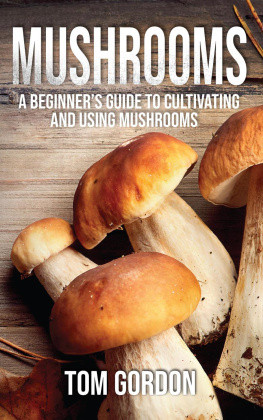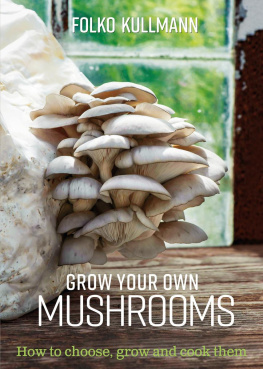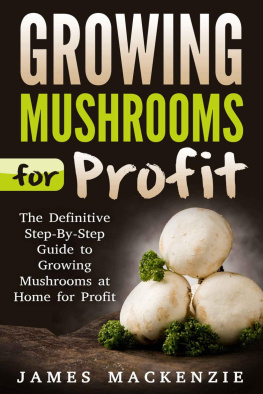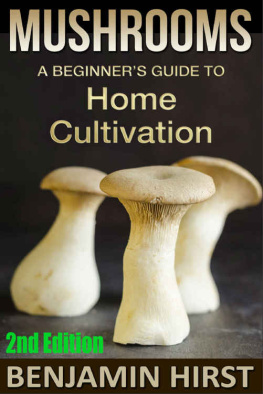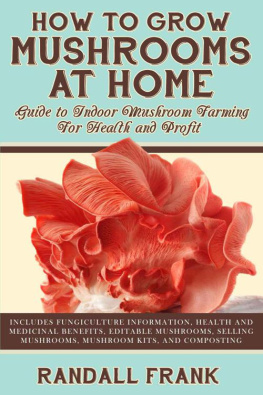Growing Mushrooms
The Essential Guide Of Advanced Techniques For Growing Shiitake, Oyster, and Several Other Popular Mushrooms
Copyright 2020 - All rights reserved.
The contents of this book may not be reproduced, duplicated, or transmitted without direct written permission from the author.
Under no circumstances will any legal responsibility or blame be held against the publisher for any reparation, damages, or monetary loss due to the information herein, either directly or indirectly.
Legal Notice:
You cannot amend, distribute, sell, use, quote, or paraphrase any part of the content within this book without the consent of the author.
Disclaimer Notice:
Please note the information contained within this document is for educational and entertainment purposes only. No warranties of any kind are expressed or implied. Readers acknowledge that the author is not engaging in the rendering of legal, financial, medical, or professional advice. Please consult a licensed professional before attempting any techniques outlined in this book.
By reading this document, the reader agrees that under no circumstances is the author responsible for any losses, direct or indirect, which are incurred as a result of the use of the information contained within this document, including, but not limited to, errors, omissions, or inaccuracies.
Table of Contents
Introduction
Almost everyone eats mushrooms, but how many of you have given any thought to growing your own? The most popular mushrooms for growing at home are the Oyster, and Shiitake mushrooms, simply because they taste so wonderful, and are one of the healthiest foods in existence. So why don't you have a go at growing your own?
What? You don't know how to?
That's not really an issue, is it? After all, you've got this guide in your hands; you don't need anything else.
Contrary to popular belief, it isn't hard to grow mushrooms at home. Some may be harder to cultivate than others but, with the right knowledge, and tools to hand, you can grow your own crops of Oyster, Shiitake, or other mushrooms I'm sure you can lay your hands on some logs or sawdust to grow them on. Common mushrooms require special compost, and you can purchases mushroom kits, but you can easily grow them on natural materials you might have lying around the house or garden.
This book will give you all the information you need to start your journey in mycology that's the official term we give to mushroom-growing , and how to successfully grow your own Shiitake, and other mushrooms, among others. Once you taste your first crop of fresh mushrooms, you won't even think about buying from a supermarket again.
Part One Introducing the Humble Mushroom
What are Mushrooms?
This is the logical place to start our journey; after all, there's little point in learning how to grow mushrooms if you don't really know what they are or how they grow.
This is the boring but necessary part of this book, and if you are not a fan of biology, you might not enjoy it. But you should. It's the only way to truly understand what you are very shortly going to be growing in your home or garden so let's dive in.
Fungus. That's what mushrooms are. They are part of the Fungi Kingdom, and there are hundreds of different ones growing that includes molds, by the way. Fungi are everywhere, and you can't always see them.
In the air, the water, all around you on the land, in your home, in plants, and animals. Pretty much anywhere or anything you can think of has fungi of some kind. Where fungi differ from plants is that they do not contain chlorophyll. This is the pigment that gives plants their green color and helps them to create energy from sunlight. Because fungi don't have this, they must absorb their food differently from their surrounding environment.
They do this by way of hyphae (a group of hyphae is called mycelium). Mycelium can stay dormant for a long time under the ground, much like the roots of some plants. Every hyphae journeys through the earth, the plants, even through wood, to get to the surface and begin growing.
Throughout the growing season, the hyphae will gradually mature into a structure that can facilitate its life cycle. The part you see growing aboveground is the mushroom, which can produce the spores and disperse them, allowing the hyphae to reproduce prolifically.
You can think of the mushroom as the plant's fruit if you like, but the seeds of that plant are spores, microscopic particles formed in the pores or gills under the mushroom cap., and each mushroom will produce millions of these.
Fungi fall into three primary categories:
Saprotrophs
Mycorrhizal
Parasites
Let's look at each of these in turn.
Saprotrophs
The word comes from a Greek word, aprs, that literally means putrid or rotten. Sounds delightful! It is apt, though, because these grow through decaying matter and consume it. They are beneficial and critical components of the decomposition ad nutrient-cycling process. You could say they are the best recyclers on the planet, with their mycelium network weaving its way through plant cell walls, breaking down just about any matter in its path.
Saprotrophs secrete acids and enzymes that break large complex molecular structures down into smaller compounds. Every ecosystem on planet earth relies on the fungi's ability to decompose organic matter; it's one of the most critical aspects of life on this planet because the result of their work is that hydrogen, carbon, nitrogen, and lots of minerals are returned to the ecosystem. In fact, it wouldn't be so far out to say that we owe our lives to fungi.
Mycorrhizal
These are another type of fungi that we owe so much to. Myco translates as mushroom, while rhizal translates as roots. A symbiotic relationship exists between these fungi and plant roots; without the fungi, many plants just couldn't grow, it's as simple as that. The mycelium network literally invades the host plant's interior cells, proving beneficial for both of them.
The plant grows faster because the mycelium living in it increases the rate the plant absorbs essential nutrients and elements. Simultaneously, because the mycelium can reach beyond the roots, it can get at the nutrients far away, nutrients it would have struggled to get any other way.
Another benefit is that plants with a relationship with the mycorrhizal fungi also have the ability to resist diseases far better than plants that don't. It has been determined that the health of any forest or woodland is dependent on these fungi the more there are, and the more varieties available, the healthier the ecosystem.
Parasites
Lastly, parasitic fungi also have an important role to play. You might think that parasites are dangerous things and, indeed, these fungi prey on host plants, usually killing the plant along the way. That doesn't sound good, but the truth goes much deeper. This type of fungi can damage the ecology that actually results in new habitats being formed for other organisms.
One such mushroom hit the headlines in the USA the Armillaria gallica. Scientists found a colony of these mushrooms in Michigan. Just one colony that covered 37 acres! It weighed in at well over 200,000 pounds and was estimated to be in the region of 1500 years old. That led to similar reports from Washington State when scientists discovered another colony, this time Armillaria ostoyae, covering over 2000 acres, and estimated at more than 2400 years old. This, a mere parasite, is second only to the Aspen forests in Colorado as one of the largest living organisms on planet earth.








